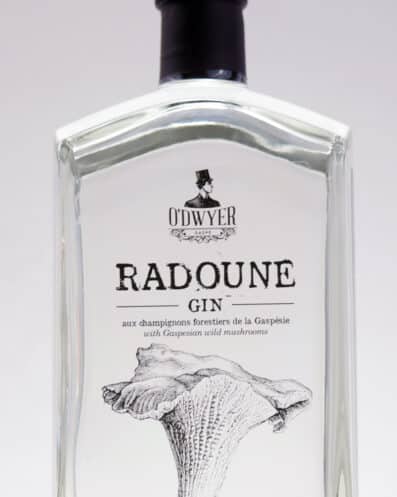Gins often celebrate a region or country’s unique botanical heritage. The team at the O’Dwyer Distillerie in Gaspé, Quebec have chosen to celebrate an unusual botanical— at least as far as gin is concerned.
The Gaspésie forests of the Gaspé Peninsula are a complex series of sea cliffs and marshes, mountains and valleys. Just north of the Gulf of St. Lawrence this area is remote. Quebec and Northern Canada are rich in mushrooms but leave the foraging to the pros*. The foraging group Gaspésie Sauvage works in this region, sustainably sourcing local, symbiotic mushrooms— the kind that can’t be grown on farms. Sauvage’s mushrooms are the ones in Radoune Gin, which is actually named for the area between two mountains where the gin’s mushrooms burst forth from the rich Gaspé soils.
The juniper berries for Radoune Gin are sourced from the owner’s backyard and then dried in sea salt(!).
Tasting Notes
The nose has a rich and earthy tone, that vaguely reminds me of Audemus Spirits’ Umami Spirit. Forest floor, damp earth. On top of that are heady notes of honeysuckle and cinnamon biscuit. It’s a complex mix of dark and light.
Radoune Gin has a heady dose of pine and juniper character as well. The umami note reminds me a bit of distilled junipers other than juniperus communis. It has a cedar and pinecone note.
Early on the palate it strikes me as having some briny, herbal character— kelp, thyme oil and marjoram; it evolves building with pine and cedar; growing gradually sweeter. On the back of the palate notes of carmelized sugar and eggy custard.
The finish is fairly long with a mentholic echo overlaying an earthy, seaweed kissed, savory undertone with a hint of baked blueberry.
Knowing what’s in Radoune Gin, you may immediately reach for those earthy notes and a mushroom metaphor. While I think they are there, the dark herbal notes and juniper touches round out Radoune Gin, into more than just a simple “mushroom gin.”
Cocktails
Radoune Gin is a curious mixer. I thought the earthiness was a little off in terms of a tonic water gin and tonic. The bitter quinine note was welcome, but I found it to work best alongside a flavored tonic syrup.
Jack Rudy’s Elderflower adds an impressively light elderflower top note, which is unusual, yet invigorating. I think my favorite might have been the balance of Radoune Gin and the earthy, floral Hibiscus tonic from Strong. Highly recommended in a Tonic Syrup Gin and Tonic.
Another drink that I think added a lot of balance to Radoune Gin was the Martini. The lovely accompaniment of bitter wormwood and dark herbs created a really captivating, complex drink that evoked feelings of an autumn garden in the rain, weeks away from harvest.
Bartenders looking to mix with Radoune Gin behind the bar are probably going to want to choose carefully how to best highlight it. It’s not necessarily a plug and play substitute for major gin brands; however, with care, especially given to its unusual and well executed flavor profile, I think it can be a quite excellent addition to any bar.
Overall
Radoune Gin is rich, unctuous and a celebration of the earth. Cocktail drinkers looking for something unusual and well executed— especially fans of Martinis— will find a lot to like about Radoune Gin. It truly is a celebration of terroir, and Radoune Gin differentiates itself from any other gin on the market in that regard. Nothing quite tastes like this gin, and I mean that in the best way.
Recommended in its category.
*And I’d recommend you do too.


Ça goûte bon la terre et la foret gaspésienne. Adorable gin. Très singulier.
Gin is my drink of choice and this is my favorite brand.
Wo bekommt man radoune gin
Where can I buy this gin ? We are from Michigan.
Thank you
Berit
The forest and earthy aroma makes smelling this gin as wonderful as drinking it. Perfect with tonic, squeeze of lemon and a splash of sparkling water.
Kann man den Gin bestellen?
Wenn ja, Wo ???